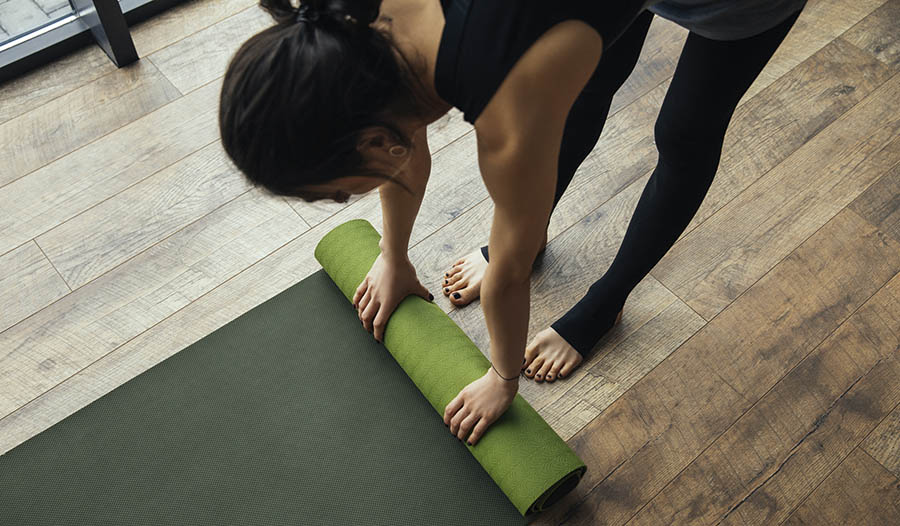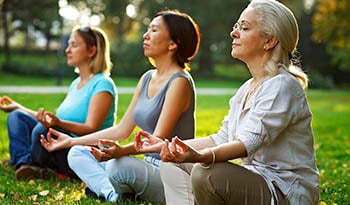How to Enhance the Benefits of Your Yoga Practice
DISCLAIMER:This blog does not intend to provide diagnosis...

More than a form of exercise, yoga is a way of life. An integrated system developed in Northern India over 5,000 years ago, yoga can transform the body, mind, heart and spirit. The word yoga comes from the Sanskrit work yuj—meaning to bind or yoke—and is frequently translated as “union.”
Yoga Styles
There are numerous yoga styles to try on your journey toward bliss. While they all utilize many of the same poses and postures—called asanas—each has a different rhythm, structure and emphasis.
- Hatha: This gentle style is the most common type of yoga taught in the West. Students practice a series of postures that align skin, muscle and bone and open the channels of the body improving the flow of energy.
- Anusara: Created by John Friend in 1997, anusara emphasizes alignment and encourages students to open their hearts and fully express themselves.
- Iyengar: Developed by B.K.S. Iyengar, this style also focuses on alignment and incorporates props to enable students to do poses properly. While the slow form won’t elevate your heart rate, it is mentally and physically challenging and great for people recovering from injury or looking to loosen tight, sore muscles.
- Hot, Bikram or Hot Power: Like to sweat? Then these styles, which follow a specific sequence of poses practiced in a heated studio (80-100 degrees F), are for you.
- Vinyasa or Flow: Want variety and aerobics? Try vinyasa. Teachers utilize flowing poses called sun salutations that warm, align and strengthen the entire body while elevating the heart rate. Music is often played, and linking movement with breath to spark mindfulness is emphasized.
- Restorative or Yin: To relax, reduce stress and elongate tight muscles try restorative or yin. Props (blocks, blankets and bolsters) provide support in a passive pose for long periods of time allowing the body to rest and rejuvenate with little effort.
Health Benefits of Yoga
All styles of yoga have numerous physical and mental benefits and fuel the body’s natural inclination toward health and healing. Relaxation techniques can decrease chronic pain (back pain, headaches and arthritis), lower blood pressure, reduce stress and ease insomnia. Regular practice can also build muscle strength, boost energy and vitality, enhance athletic performance, prevent injury and increase body awareness. Mental benefits include feeling relaxed, centered and more peaceful, mindful and positive.
Flowing, aerobic styles (power, hot and vinyasa) burn calories facilitating weight loss. Styles that emphasize holding poses longer and elongating muscles, such as yin, promote flexibility, relieve stiffness and increase joint mobility, especially in the hips, spine and pelvis.
Supplements to Support Your Yoga Practice
Since yoga views the body as a tool to prepare the mind and nourish the soul, taking supplements and eating right is important and will provide energy and nutrients for tissue repair.
- Multivitamins: Consuming a healthy, balanced diet consisting of unprocessed, unrefined, real food is one of the best things you can do to support your body and yoga practice. However, to cover all your body’s needs take a good daily multivitamin. Choose a whole food-based formula, which is better for the body than synthetic products.
- Anti-Inflammatory Formulas: Any form of exercise, including yoga, can cause inflammation. Eating anti-inflammatory foods (fruits, vegetables, fatty fish and nuts), getting adequate sleep, managing stress and taking an inflammation support supplement can help. To aid muscle recovery look for products that contain ingredients such as antioxidants, ginger, alpha-lipoic acid, fish oil and curcumin.
- Probiotics: Feeling bloated or imbalanced? Regular yoga practice can help by cleansing, stimulating and aiding digestion. A good probiotic can also improve gut health, the immune system and overall wellbeing.
- B12: While you don’t have to forgo meat to practice yoga, vegetarian and vegan diets are popular among those who practice regularly. Avoiding meat can result in a lack of B12, a vitamin only found in foods of animal origin that is crucial for energy metabolism. Low levels are also common in people over 50 and can cause weakness, fatigue and memory loss.
- Coenzyme Q10: Similar to a vitamin, CoQ10 is made by the body and found in many whole foods including organ meats, sardines and peanuts. This antioxidant prevents tissue damage by neutralizing unstable molecules called free radicals and supports oxygen use and energy production.
- Essential oils: Essential oils can support yoga practice in many ways. Create a yoga mindset by sniffing harmonizing sandalwood, heart-soothing rose or clarity-boosting rosemary. Smelling jasmine, sweet orange or lavender can elevate mood and help balance the nervous system. To relieve sore muscles, spray a mixture of rosemary, peppermint and cinnamon essential oils combined with arnica and coconut oil. A mixture of tea tree and lavender combined with water and a little white vinegar can be used as a yoga mat sanitizer.

 By Dr. Ellen Albertson, PhD, RDN, NBC-HWC
By Dr. Ellen Albertson, PhD, RDN, NBC-HWC


